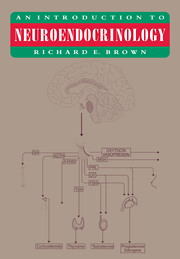Book contents
- Frontmatter
- Contents
- Preface
- Acknowledgements
- Illustration credits
- List of abbreviations
- 1 Classification of chemical messengers
- 2 The endocrine glands and their hormones
- 3 The pituitary gland and its hormones
- 4 The hypothalamic hormones
- 5 Neurotransmitters
- 6 Neurotransmitter control of hypothalamic, pituitary and other hormones
- 7 Regulation of hormone synthesis, storage, release, transport and deactivation
- 8 Regulation of hormone levels in the bloodstream
- 9 Steroid and thyroid hormone receptors
- 10 Receptors for peptide hormones, neuropeptides and neurotransmitters
- 11 Neuropeptides I: classification, synthesis and colocalization with classical neurotransmitters
- 12 Neuropeptides II: neuropeptide function
- 13 Cytokines and the interaction between the neuroendocrine and immune systems
- 14 Methods for the study of behavioral neuroendocrinology
- 15 An overview of behavioral neuroendocrinology: present, future and past
- Appendix Journals in endocrinology, neuroendocrinology, psychoneuroimmunology and behavioral endocrinology
- Index
13 - Cytokines and the interaction between the neuroendocrine and immune systems
Published online by Cambridge University Press: 26 December 2009
- Frontmatter
- Contents
- Preface
- Acknowledgements
- Illustration credits
- List of abbreviations
- 1 Classification of chemical messengers
- 2 The endocrine glands and their hormones
- 3 The pituitary gland and its hormones
- 4 The hypothalamic hormones
- 5 Neurotransmitters
- 6 Neurotransmitter control of hypothalamic, pituitary and other hormones
- 7 Regulation of hormone synthesis, storage, release, transport and deactivation
- 8 Regulation of hormone levels in the bloodstream
- 9 Steroid and thyroid hormone receptors
- 10 Receptors for peptide hormones, neuropeptides and neurotransmitters
- 11 Neuropeptides I: classification, synthesis and colocalization with classical neurotransmitters
- 12 Neuropeptides II: neuropeptide function
- 13 Cytokines and the interaction between the neuroendocrine and immune systems
- 14 Methods for the study of behavioral neuroendocrinology
- 15 An overview of behavioral neuroendocrinology: present, future and past
- Appendix Journals in endocrinology, neuroendocrinology, psychoneuroimmunology and behavioral endocrinology
- Index
Summary
As pointed out in Chapter 1, the nervous, endocrine and immune systems interact in many ways. Damage to the brain or changes in neurotransmitter and neurohormone release alter immune responses and the chemical messengers released by the cells of the immune system can alter the activity of the nervous and endocrine systems (Smith and Blalock, 1986; Kordon and Bihoreau, 1989). This chapter begins with an overview of the cells of the immune system and their chemical messengers, the cytokines, and then discusses the immune functions of the thymus gland and its hormones. The functions of the cytokines in the immune response to antigens and in the development of blood cells are then summarized and the neuromodulatory effects of cytokines on the brain and neuroendocrine system are examined. This is followed by a discussion of the neural and endocrine regulation of the immune system and the hypothalamic integration of neural, endocrine and immune systems.
THE CELLS OF THE IMMUNE SYSTEM
The immune system consists of a number of different cell types, including the monocytes and macrophages, T lymphocytes (T cells), B lymphocytes (B cells), granulocytes and natural killer (NK) cells. The role of the immune system is to help maintain homeostasis in the body and its best known function is the protection of the body from foreign invaders such as bacteria and viruses and from abnormal cellular development as occurs in tumor cells. To do this, the immune system must be able to discriminate foreign (non-self) cells from the body's own cells (self). Almost all substances have regions called antigenic determinants or ‘epitopes’ which can stimulate an immune response.
- Type
- Chapter
- Information
- An Introduction to Neuroendocrinology , pp. 302 - 345Publisher: Cambridge University PressPrint publication year: 1994



